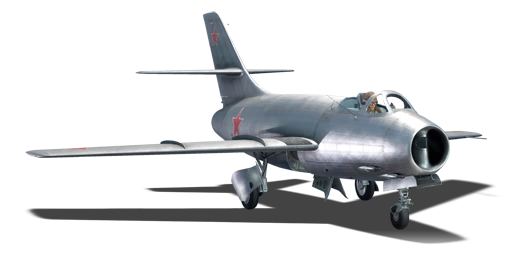



The Yak-30 was Yakovlev's attempt to compete with Mikoyan-Gurevich after the limited success of the Yak-23 and all their jets using the Yak-3 fuselage. The Yak-30 was a completely new design based on the experimental Yak-25, however this variant included a swept wing for better performance at high speeds. The aircraft test trials started after its first flight in 1948 but it proved unsatisfactory, thus a new version with most of the problems fixed was developed, the Yak-30D. This new variant showed good results but the superior MiG-15 was already in production and thus the project was cancelled.
It was introduced in Update 1.59 "Flaming Arrows". The Yak-30D is a very capable jet fighter with a playstyle very similar to that of contemporary Soviet fighters like the La-15 and MiG-15. The Yak-30D excels at high speed performance (around 800-900 km/h), it's capable of more than 1,000 km/h at sea level when the thrust is set to 112%, note that this extra power consumes more fuel. However, the engine is better accelerating at lower speeds and at more than 850 km/h it loses energy relatively fast in any manoeuvres. The aircraft compresses significantly at high speeds and control of the aircraft is tricky, thus for avoiding missiles or starting dogfights it is better to lose speed to around 800-900 km/h. However, unlike the Yak-23, the Yak-30D has an airbrake to lose that unnecessary speed when needed.
flaps
flaps
flaps
brake
| Belt | Belt filling | Armor penetration (mm) at a distance: | |||||
|---|---|---|---|---|---|---|---|
| 10 m | 100 m | 500 m | 1000 m | 1500 m | 2000 m | ||
| AP-I/FI-T | 32 | 30 | 22 | 15 | 10 | 7 | |
| FI-T/AP-I/AP-I/AP-I | 32 | 30 | 22 | 15 | 10 | 7 | |
| FI-T/FI-T/FI-T/AP-I | 32 | 30 | 22 | 15 | 10 | 7 | |
| AP-I | 32 | 30 | 22 | 15 | 10 | 7 | |
| Belt | Belt filling | Armor penetration (mm) at a distance: | |||||
|---|---|---|---|---|---|---|---|
| 10 m | 100 m | 500 m | 1000 m | 1500 m | 2000 m | ||
| AP-I/FI-T | 32 | 30 | 22 | 15 | 10 | 7 | |
| FI-T/AP-I/AP-I/AP-I | 32 | 30 | 22 | 15 | 10 | 7 | |
| FI-T/FI-T/FI-T/AP-I | 32 | 30 | 22 | 15 | 10 | 7 | |
| AP-I | 32 | 30 | 22 | 15 | 10 | 7 | |












Flight performance | |
|---|---|
Survivability |
|---|
Weaponry |
|---|